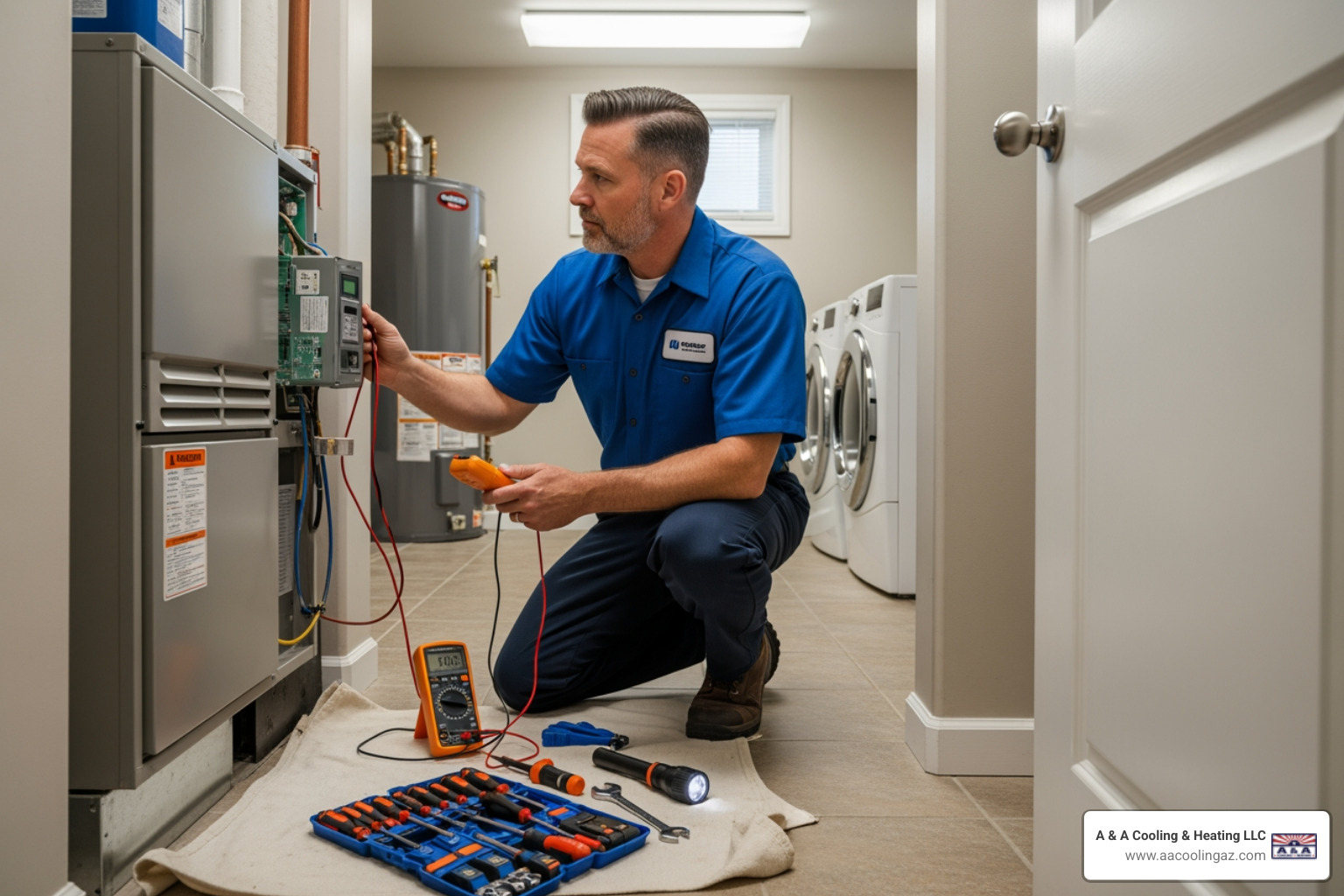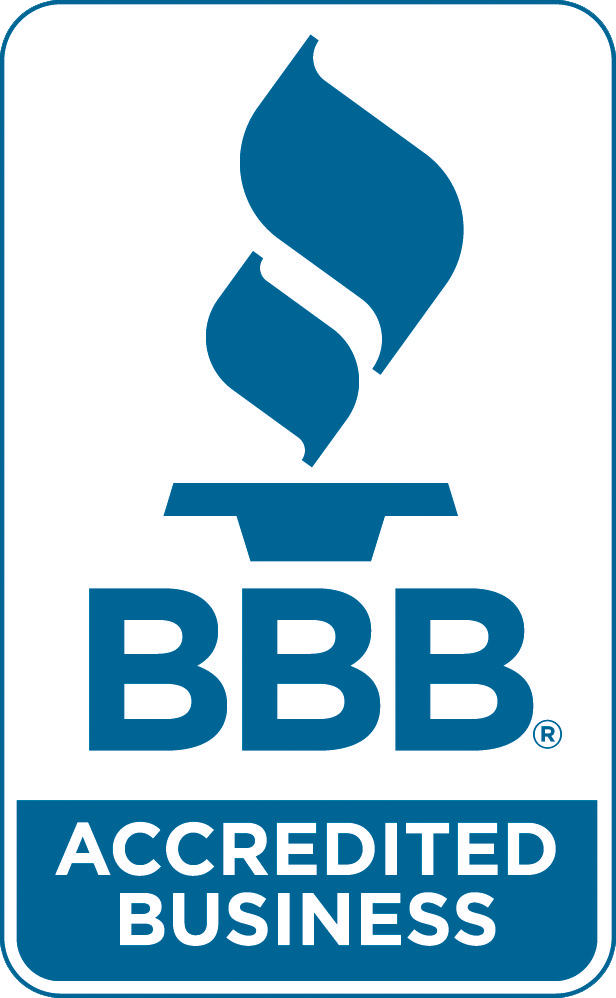Don't Freeze: Quick Guide to Emergency Furnace Services
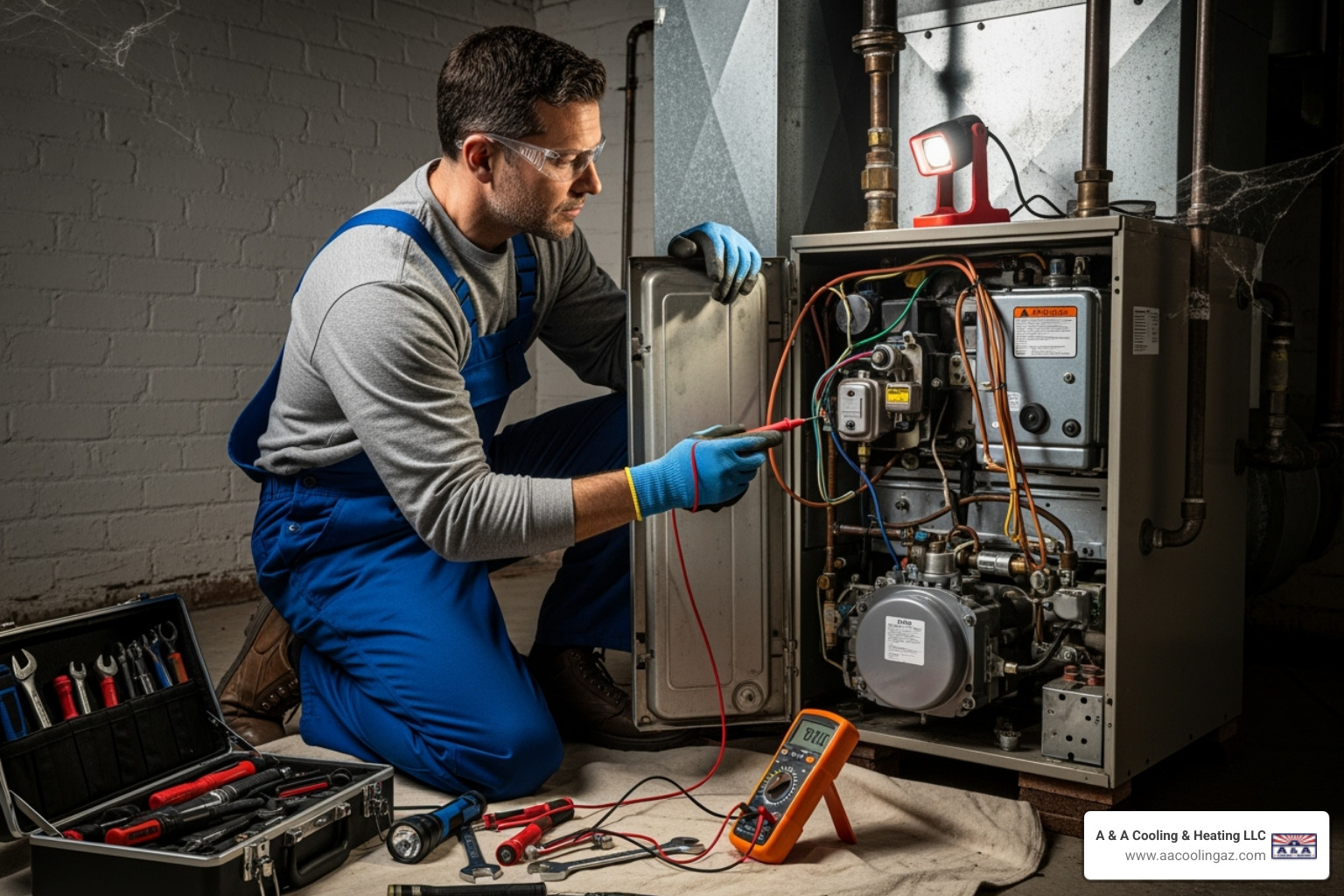
When Your Home's Heat Goes Out: Understanding Emergency Furnace Situations
When your furnace fails, knowing what constitutes a true emergency furnace repair is crucial for your family's safety and your budget. While some issues can wait, others demand immediate professional attention.
True furnace emergencies include:
- No heat during freezing weather (below 32°F)
- Strong gas or rotten egg smell (evacuate immediately)
- Carbon monoxide alarm activation
- Loud banging, scraping, or screeching noises
- Visible smoke or burning electrical smells from the unit
- Water leaking around the furnace
Non-emergency issues that can often wait:
- Furnace cycling on and off frequently
- Uneven heating between rooms
- Higher than normal energy bills
- Minor unusual sounds during startup
In Apache Junction's desert climate, winter nights can get cold enough for a heating failure to pose health risks, especially for children, the elderly, and those with medical conditions.
The key is to know when you can troubleshoot safely versus when you must call a professional. While you can often fix a dead thermostat battery or tripped breaker, issues like gas leaks, CO alarms, or total system failure require expert intervention.
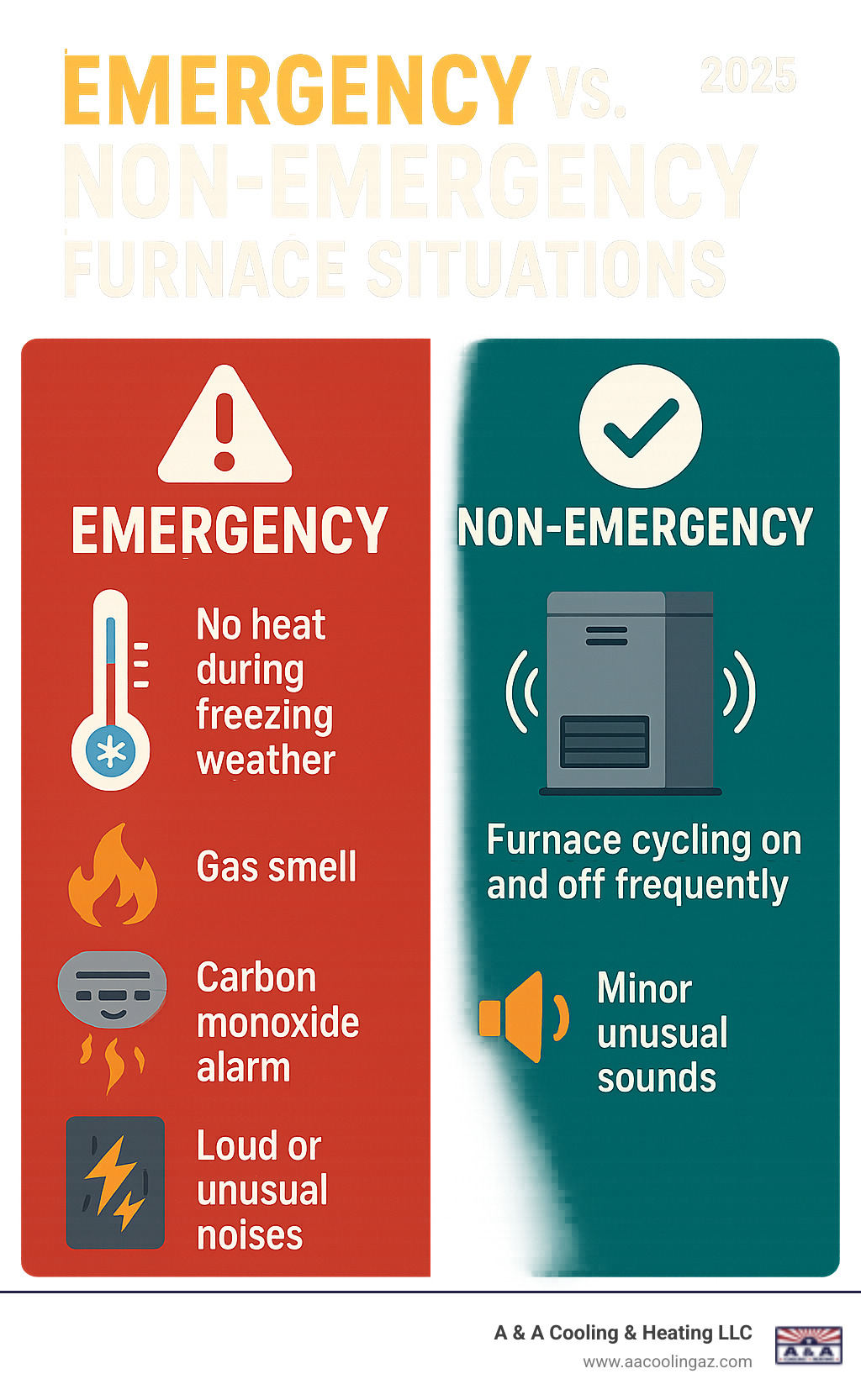
Is It a Real Furnace Emergency? Identifying Critical Signs
When your furnace acts up, it's important to distinguish between a minor issue and a genuine crisis. Knowing the signs of a true emergency furnace repair situation is key to keeping your family safe.
No heat during cold weather is a clear emergency. When temperatures drop, a lack of heat is more than an inconvenience; it's a health risk. The CDC's Heat & Health Tracker confirms that cold exposure is especially dangerous for young children, the elderly, and those with medical conditions.
A gas smell or a rotten egg odor is a critical warning. Natural gas companies add this scent to alert you to leaks. If you smell it, evacuate everyone immediately. Do not use any electrical devices, and call your gas company and the fire department from a safe location outside your home.
If your carbon monoxide alarm sounds, treat it as a real emergency. This colorless, odorless gas is deadly, and a faulty furnace is a common source. Get everyone out of the house immediately and call 911.
Your furnace should not make loud banging noises, scraping sounds, or screeching noises. These sounds often indicate serious mechanical problems that could lead to a complete breakdown. For a detailed breakdown, see our guide on scary furnace sounds you should never ignore.
Visible smoke or a burning electrical smell points to overheating or an electrical fault that could cause a fire. Turn the system off and call for help. Likewise, while some condensation is normal on high-efficiency units, excessive water pooling around your furnace indicates a problem like a clogged drain or cracked heat exchanger.
When you're facing potential health risks from cold exposure or any safety concerns, it's always better to err on the side of caution. For a comprehensive look at when to seek immediate professional help, read our article on signs you need immediate furnace repair. Trust your instincts—if it feels like an emergency, it probably is.
Common Causes of Sudden Furnace Failure
When your furnace suddenly stops working, it's often for a predictable reason. Understanding these common culprits can help you determine if you have a quick fix or need emergency furnace repair.
Thermostat Troubles: Before panicking, check your thermostat. Dead batteries are a frequent cause of failure. Also, ensure the thermostat is set to "Heat" and the temperature is set higher than the current room temperature.
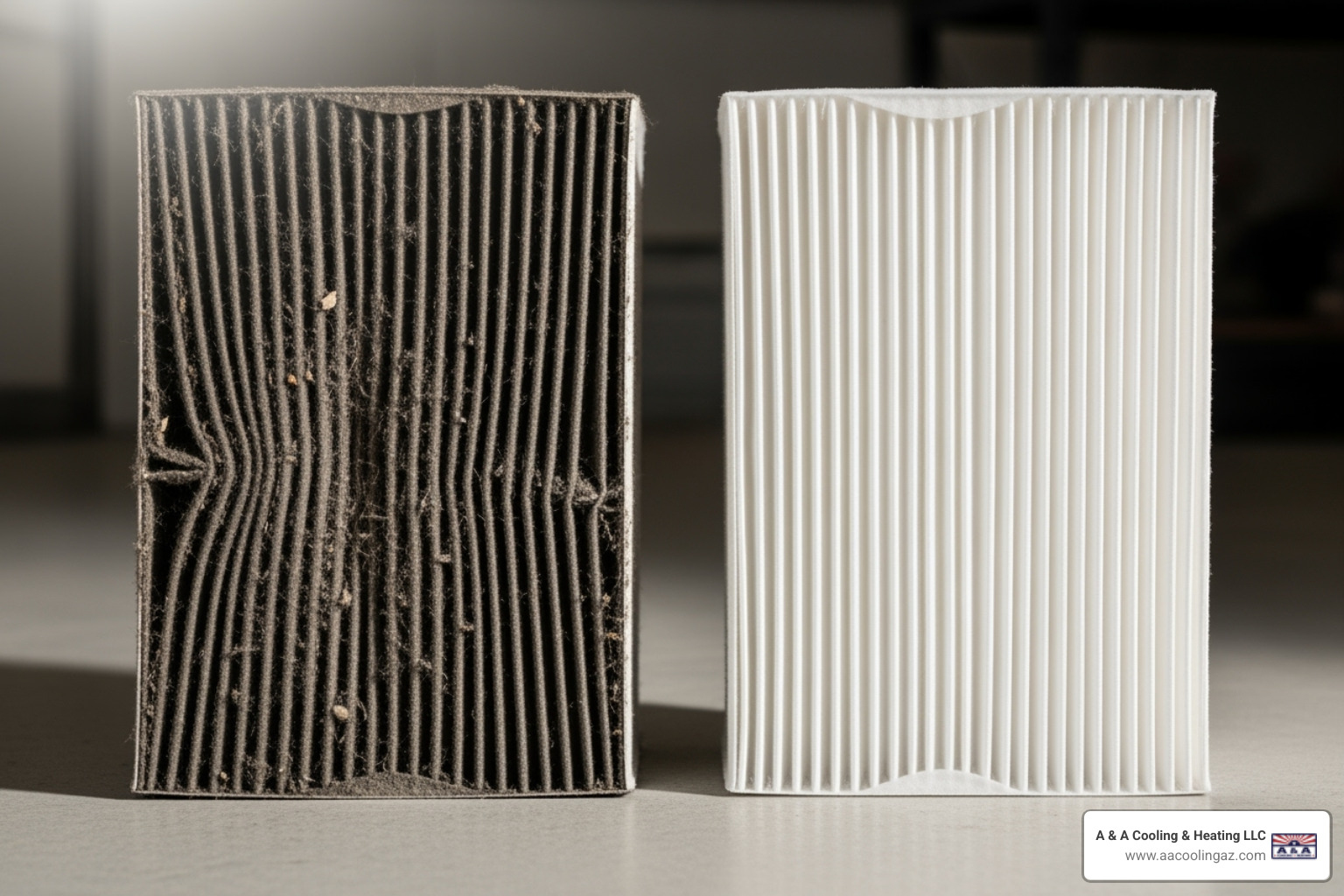
Dirty Air Filters: A clogged filter forces your furnace to work harder to pull in air, which can cause it to overheat and shut down as a safety measure. Regularly replacing your filter is one of the easiest ways to prevent this.
Ignition System Failure: If you have an older furnace, the pilot light may have gone out. Newer systems with electronic ignition can fail if the flame sensor is dirty or the igniter breaks. This can lead to an ignition lockout, where the system shuts down after several failed attempts to light. Our guide on how do you fix a furnace ignition lockout can provide more insight.
Electrical Problems: A simple tripped breaker can cut power to your furnace. However, if the breaker trips repeatedly, it signals a more serious electrical issue that requires a professional. Faulty wiring or a failed control board can also shut the system down.
Wear and Tear: Like any mechanical system, furnace parts wear out over time. Blower motors, belts, and other components can fail unexpectedly, especially in older units. For a deeper dive, see our article on what causes a heating system to stop working.
What to Do When Your Furnace Stops: A Homeowner's First Response
Waking up to a freezing house is alarming, but don't panic. Before calling for emergency furnace repair, there are several simple troubleshooting steps you can take that might solve the problem.
Safety always comes first. If you smell gas, see smoke, or hear loud banging or scraping sounds, skip troubleshooting. Evacuate your home and call for professional help immediately.
For non-critical issues, a systematic check can often reveal a simple fix. Note whether the furnace is completely silent or making noise without producing heat, as this information is helpful for a technician.
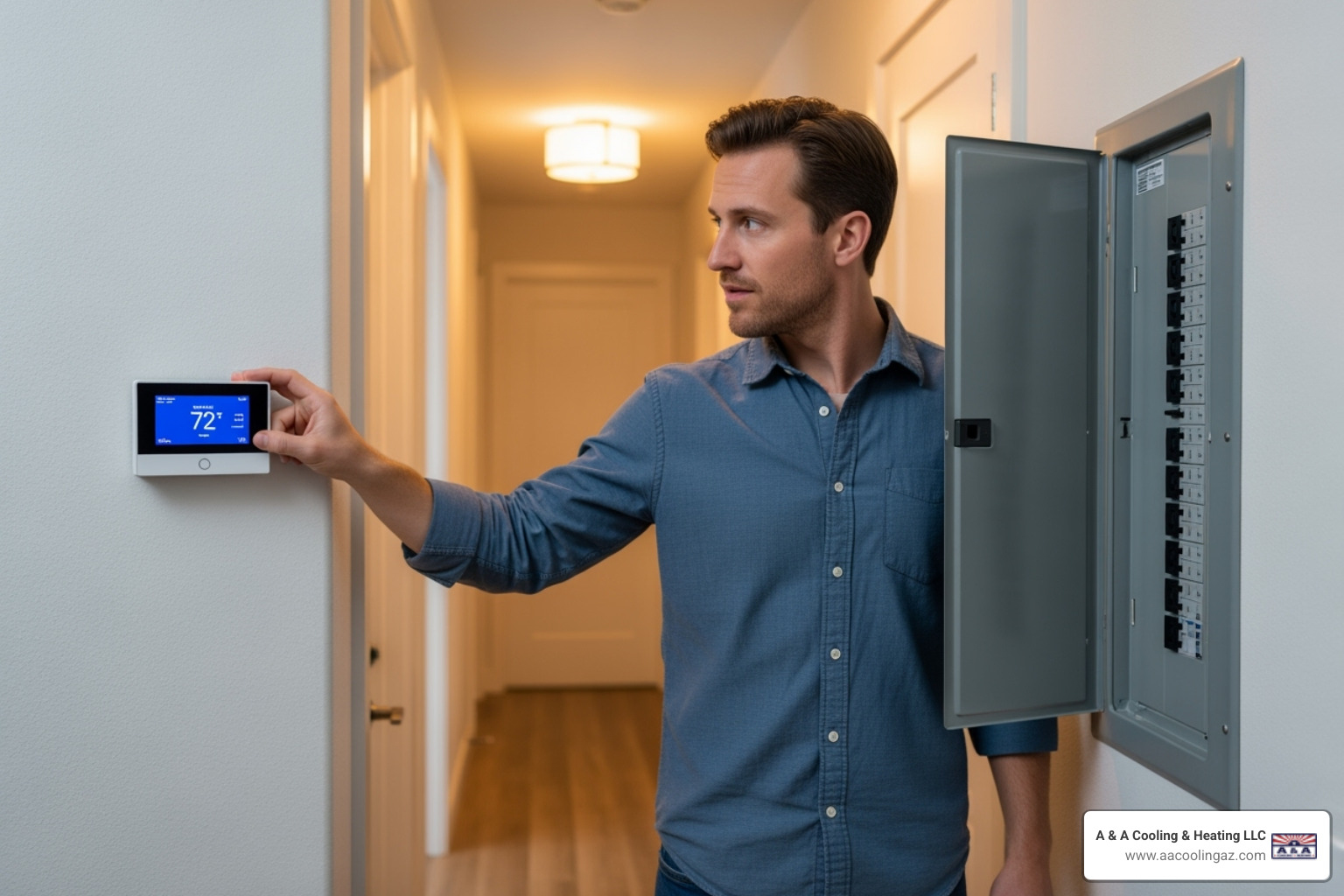
Simple DIY Troubleshooting Steps
Many furnace "failures" have surprisingly simple solutions. Walk through these basic checks before assuming the worst.
1. Check the Thermostat: This is the most common culprit. Ensure it's set to "Heat" and the temperature is at least five degrees above the current room temperature. If the display is blank or acting erratically, replace the batteries.
2. Inspect Power Sources: Check your electrical panel for a tripped breaker labeled "Furnace" or "HVAC." If it's tripped, switch it fully to the "off" position, then back to "on." Also, find the furnace's power switch (it looks like a light switch on or near the unit) and make sure it's in the "on" position. If the breaker trips again, you have a larger electrical issue that needs a professional.
3. Examine Airflow: A severely clogged air filter can cause your furnace to overheat and shut down. Pull out the filter; if you can't see light through it, replace it. At the same time, make sure all your heating vents and registers are open and not blocked by furniture or rugs. Keep the area around the furnace unit itself clear for at least three feet. Our Troubleshooting tips for heater not working article offers more detailed guidance.
After these checks, give the system a few minutes to restart. If you're still without heat, or if you're uncomfortable performing these steps, it's time to call a professional. Knowing your limits is key to staying safe.
When to Call for Professional Emergency Furnace Repair
While DIY troubleshooting can solve minor issues, some problems require the expertise and tools of a trained technician. For your safety and to prevent further damage, it's crucial to know when to call for emergency furnace repair.
Key Signs You Need Emergency Furnace Repair
If you've tried basic troubleshooting without success, or if you notice any of the following red flags, it's time to call a professional:
- Strong Gas Smell or CO Alarm: Evacuate immediately and call 911 or your utility company from a safe location.
- Loud Mechanical Noises: Banging, grinding, or screeching indicates serious internal damage that could lead to a total system failure.
- No Heat During Freezing Temperatures: This is a health and safety risk, especially for vulnerable family members.
- Electrical Issues: A burning smell, sparks, or a breaker that repeatedly trips requires an expert to prevent a fire hazard. For more on this, see our blog on Signs you need heating repair.
- Water Leaks: Pooling water can signal a cracked heat exchanger or a clogged drain, creating an electrical hazard.
If you encounter any of these signs, or if your DIY efforts fail, don't hesitate to call for help. Attempting complex repairs yourself can be dangerous and may void your warranty. For more Reasons to call for furnace repair, check out our detailed guide.
Choosing the Right Emergency HVAC Service
When you need urgent help, you need a reliable team. Here’s what to look for in an emergency HVAC company:
- 24/7 Availability: The company must be available around the clock, because emergencies don't stick to a 9-to-5 schedule.
- Licensed and Insured Technicians: This ensures they have the proper training and that you are protected from liability.
- Background-Checked Technicians: You should feel safe and secure with anyone you invite into your home.
- Upfront Estimates: A reputable company provides a clear quote before work begins, so there are no surprises.
- Satisfaction Guarantee: Look for a company that stands behind its work, demonstrating confidence in its service quality.
- Positive Reviews and Reputation: A strong track record of satisfied customers is a good indicator of reliable service.
We pride ourselves on meeting all these criteria. For more on what makes a company a good choice, see our insights on Furnace repair in Gold Canyon, AZ - Why Choose Us.
Preventing Future Breakdowns: Maintenance and Preparation
No one wants to deal with an emergency furnace repair. The good news is that most furnace emergencies are preventable with proactive care. Investing in your furnace's health extends its life, improves efficiency, and provides peace of mind.
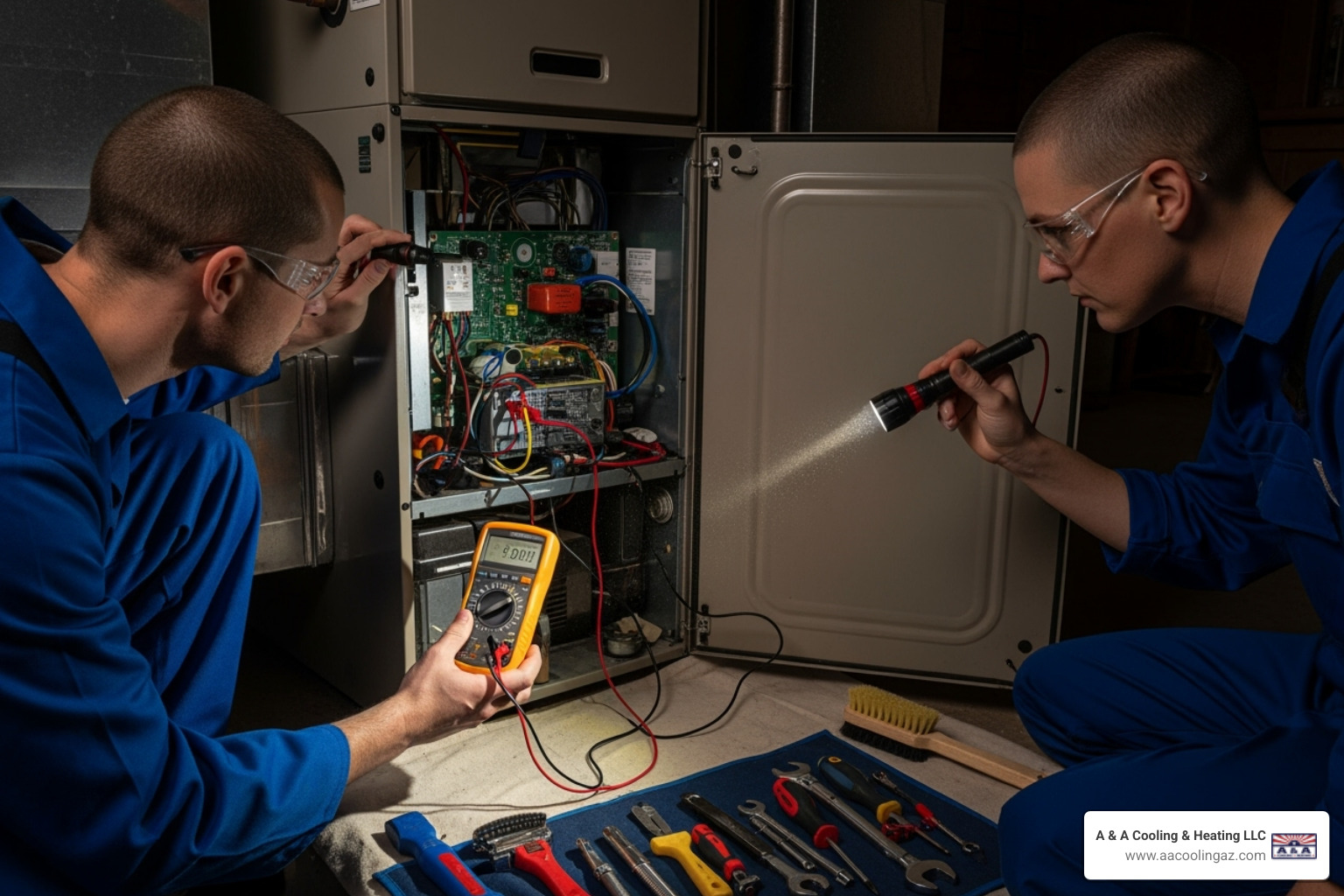
The Power of Regular Maintenance
The best way to avoid an emergency is with proactive care. Just like a car, your furnace needs regular attention to run reliably.
Annual tune-ups, ideally in the fall, are the cornerstone of furnace health. A professional tune-up improves efficiency (lowering your energy bills), extends system longevity, and includes vital cleaning of internal components. Most importantly, it involves safety checks for gas leaks or carbon monoxide risks and allows technicians to catch small problems before they become major breakdowns. As we explain in our posts, you should not skip HVAC maintenance because a furnace tune-up extends lifespan. Our Essential furnace maintenance tips provide additional guidance for keeping your system in top shape.
Is It Time for a Furnace Replacement?
Even a well-maintained furnace has a limited lifespan. Recognizing the signs of a failing system can help you plan a replacement before you're left in the cold.
- Furnace Age: Most gas furnaces last 15-20 years. If yours is in this range, it's wise to start planning for a replacement.
- Frequent Repairs: If you're calling for service multiple times a year, the cost of repairs can quickly add up, making a replacement more economical.
- Rising Energy Bills: A sudden, unexplained increase in your heating bills often signals that your furnace is losing efficiency as it ages.
- Uneven Heating: Cold spots and inconsistent temperatures throughout your home can mean your furnace is no longer able to distribute heat effectively.
- Safety Concerns: An older furnace with a yellow pilot light (it should be blue) or soot around the registers could be producing carbon monoxide, a serious safety hazard.
For homeowners wondering about replacement timing, our comprehensive guide When to consider home furnace replacement provides detailed insights into making this important decision.
Frequently Asked Questions about Emergency Furnace Services
When you're facing a sudden furnace failure, you're bound to have questions. As a trusted HVAC provider in Apache Junction since 1976, we've answered them all. Here are some of the most common questions we hear during an emergency furnace repair call.
Why is my furnace running but blowing cold air?
This frustrating problem means the blower is working, but the heating component is not. Common causes include a very dirty air filter restricting airflow and causing a safety shutdown of the burners, an incorrect thermostat setting, or a problem with the ignition system (like a pilot light that's out or a failed electronic igniter). While you can check the filter and thermostat, other causes require a professional diagnosis, as some can involve serious safety issues.
Can I use space heaters safely while waiting for a repair?
Yes, modern space heaters can be a good temporary solution if used safely. Always follow these rules:
- Place the heater on a flat, hard, non-flammable surface.
- Keep a three-foot clear space around the heater, away from curtains, bedding, and furniture.
- Never leave a space heater running unattended or while you sleep.
- Plug the heater directly into a wall outlet, never into an extension cord or power strip.
Space heaters are for temporary, localized heat and are not an efficient long-term solution for heating your entire home.
What's the difference between a furnace lockout and a total failure?
A furnace lockout is a safety feature. It occurs when the furnace tries to ignite several times and fails, shutting down to prevent a potentially unsafe condition. This is often caused by a dirty flame sensor or an airflow problem and can sometimes be reset. A total failure is more serious, where the furnace shows no signs of life at all. This usually points to a major component failure, such as a dead motor, a failed control board, or a significant electrical problem. A lockout might be a simple fix, but a total failure almost always requires professional repair.
Conclusion
A furnace failure doesn't have to be a crisis. By understanding the difference between a minor issue and a true emergency, you can respond with confidence. Many problems can be solved with simple DIY checks, like replacing thermostat batteries or checking a circuit breaker.
However, your safety is always the top priority. Strong gas smells, carbon monoxide alarms, and no heat in freezing weather are non-negotiable signs to call for professional help immediately. For complex mechanical or electrical issues, trust a licensed technician to perform the repair safely and correctly.
The best way to avoid these stressful situations is through prevention. Regular maintenance is the key to a reliable, efficient, and safe heating system. An annual tune-up can catch problems early and save you from an unexpected breakdown.
At A & A Cooling & Heating LLC, we've been keeping Arizona families comfortable since 1976. We know that furnace problems don't wait for business hours, and we're here when you need us most. Whether you need a fast repair or are considering a new system, we provide the reliable, professional service you deserve.
Don't let a furnace emergency leave you in the cold. When you need dependable emergency furnace repair service, we're just a phone call away. Contact us for expert furnace repair in Tempe, AZ, and let us restore warmth and comfort to your home.







